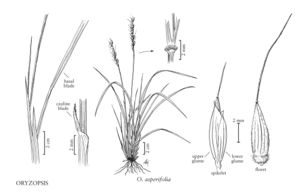| Taxon | Illustrator ⠉ | |
|---|---|---|
 | Oryzopsis asperifolia | Annaliese Miller |
Plants perennial; cespitose, not rhizomatous. Culms 25-65 cm, erect or spreading, basal branching extravaginal; prophylls not visible; nodes glabrous. Leaves mostly basal; cleistogenes not developed; sheaths open, glabrous; auricles absent; ligules membranous, longest at the sides or rounded, ciliate; blades of basal leaves 30-90 cm, remaining green over winter, erect when young, recumbent in the fall, bases twisted, placing the abaxial surfaces uppermost, cauline leaf-blades reduced, flag leaf-blades 2-12 mm, conspicuously narrower than the top of the sheath. Inflorescences panicles, contracted. Spikelets 5-7.5 mm, with 1 floret; rachillas not prolonged beyond the base of the floret; disarticulation above the glumes, beneath the floret. Glumes subequal, 6-10-veined, apices mucronate; florets terete to laterally compressed; calluses usually less than 1/5 the length of the florets, blunt, distal portions pilose; lemmas coriaceous, pubescent at least basally, 3-5 (9) -veined, margins strongly overlapping at maturity, awned, lemma-awn junction conspicuous, lobed, lobes 0.1-0.2 mm; awns more or less straight, deciduous; paleas similar to the lemmas in length, texture, and pubescence, concealed by the lemmas, 2-veined, flat between the veins; lodicules 2, free, membranous, 2-veined; anthers 3; styles 1, with 2 branches; ovaries glabrous. Caryopses falling with the lemma and palea. x = 11, 12.
Distribution
Wash., Wis., W.Va., Colo., Wyo., N.H., N.J., N.Mex., N.Y., Pa., R.I., Va., Conn., Mass., Maine, Vt., Ill., Ind., Iowa, Idaho, Md., Ohio, Utah, Minn., Mich., N.Dak., S.Dak., Mont., Alta., B.C., Man., N.B., Nfld. and Labr. (Labr.), N.S., N.W.T., Ont., P.E.I., Que., Sask., Yukon
Discussion
Oryzopsis is treated here as a monospecific genus that is restricted to North America. Hitchcock (1951) and Johnson (1945) treated it as including both Eurasian and North American taxa; Freitag (1975) and Tutin (1980) placed the Eurasian species in a separate genus, Piptatherum. Kam and Maze (1974) demonstrated that O. asperifolia differs from both North American and Eurasian species previously included in Oryzopsis in the development of its floret and callus, and in having 2-veined lodicules. Phylogenetic studies based on ITS sequence data have not yielded clear support for any particular treatment of Oryzopsis; they are consistent with the treatment presented here. The North American species previously included in Oryzopsis have been transferred to Achnatherum and Piptatherum.
Selected References
Lower Taxa
"decumbent" is not a number."prolonged" is not a number."longest" is not a number.